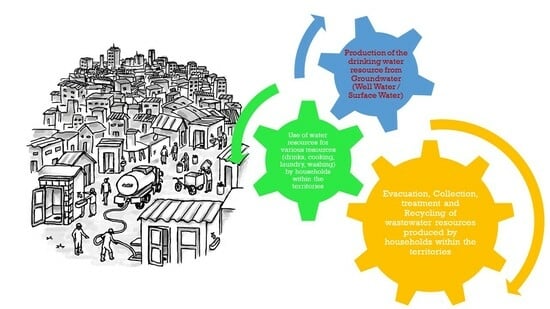Urban Governance and Sanitation in the Peri-Urban Commune of Agoè-Nyvé 6 in Togo: Diagnosis of the Sanitation System in Adétikopé
Abstract
:1. Introduction
2. Materials and Methods
2.1. Study Framework
2.1.1. Geographical Scope of the Study
2.1.2. Scientific Framework
2.2. Study Material
Study Population
2.3. Study Methods
2.3.1. Type of Study
2.3.2. Method Used for Data Collection
2.3.3. Sampling
2.3.4. Data Collection Techniques and Tools
2.3.5. Conduct of the Survey
2.3.6. Data Processing
2.4. Ethical Aspects of Research
2.5. Difficulties Encountered
3. Results
3.1. Household Solid and Liquid Waste Management
3.2. Household Water Supply
3.3. Household Wastewater Management
| Indicators | Terms and Conditions | % | p. Values |
|---|---|---|---|
| Discharge points for kitchen water | In the courtyard of the house | 6.16% | <0.001 |
| In a sump | 1.37% | <0.001 | |
| On the public highway | 78.77% | - | |
| On an undeveloped plot | 13.70% | <0.001 | |
| Total | 100.00% | ||
| Discharge points for washing water | In the courtyard of the house | 8.90% | <0.001 |
| On the public highway | 78.77% | - | |
| On an undeveloped plot | 12.33% | <0.001 | |
| Total | 100.00% | ||
| Drainage/discharge of wastewater | Septic tank | 58.22% | - |
| On the public highway | 6.16% | <0.001 | |
| On an undeveloped plot | 32.19% | <0.001 | |
| In a sump | 3.42% | <0.001 | |
| Total | 100.00% | ||
| Existence of latrines in the concession | Yes | 85.62% | - |
| No | 14.38% | <0.001 | |
| Total | 100.00% | ||
| Types of latrines | Traditional pit | 54.40% | - |
| Ventilated improvised pit (VIP) latrines | 30.47% | <0.001 | |
| Manual flush toilet (TCM) | 15.13% | <0.001 | |
| Total | 100% | ||
| Condition of latrines | Good | 93.60% | - |
| Acceptable | 4.00% | <0.001 | |
| Bad | 2.40% | <0.001 | |
| Total | 100% | ||
| Frequency of toilet/latrine maintenance | Twice a month | 68.00% | - |
| Once a month | 0.80% | <0.001 | |
| Once a week | 31.20% | <0.001 | |
| Total | 100% | ||
| Frequency of latrine emptying | Once every 3 years | 2.40% | <0.001 |
| Once every 2 years | 3.20% | <0.001 | |
| Once a year | 1.60% | <0.001 | |
| Never | 66.40% | - | |
| Do not know | 26.40% | <0.001 | |
| Total | 100% |
| Indicators | Terms and Conditions | % | p. Values |
|---|---|---|---|
| Method of emptying the pit once it has been filled | Emptying truck | 5.48% | <0.001 |
| Never emptied + do not know | 80.14% | <0.001 | |
| Total | 85.62% | ||
| Final treatment after emptying | Do not know | 99.20% | <0.001 |
| Other | 0.80% | <0.001 | |
| Total | 100% | ||
| Places where latrines are not available | In the wild | 66.67% | <0.001 |
| The neighbors | 14.28% | <0.001 | |
| In a public toilet | 19.05% | <0.001 | |
| Total | 100% | ||
| Places where children’s feces are discharged | In a toilet | 14.38% | <0.001 |
| In the wild | 85.62% | <0.001 | |
| Total | 100.00% | ||
| Observation of flooding in the concession during the rainy season | Yes | 12.33% | <0.001 |
| No | 87.67% | <0.001 | |
| Total | 100.00% | ||
| Observation of flooding in the neighborhood | Yes | 11.64% | <0.001 |
| No | 88.36% | <0.001 | |
| Total | 100.00% | ||
| Knowledge of what happens to the place where the lorries are emptied | Yes | 67.12% | <0.001 |
| No | 32.88% | <0.001 | |
| Total | 100.00% | ||
| Condition of gutters | Bad | 0.68% | <0.001 |
| Do not exist | 99.32% | <0.001 | |
| Total | 100.00% |
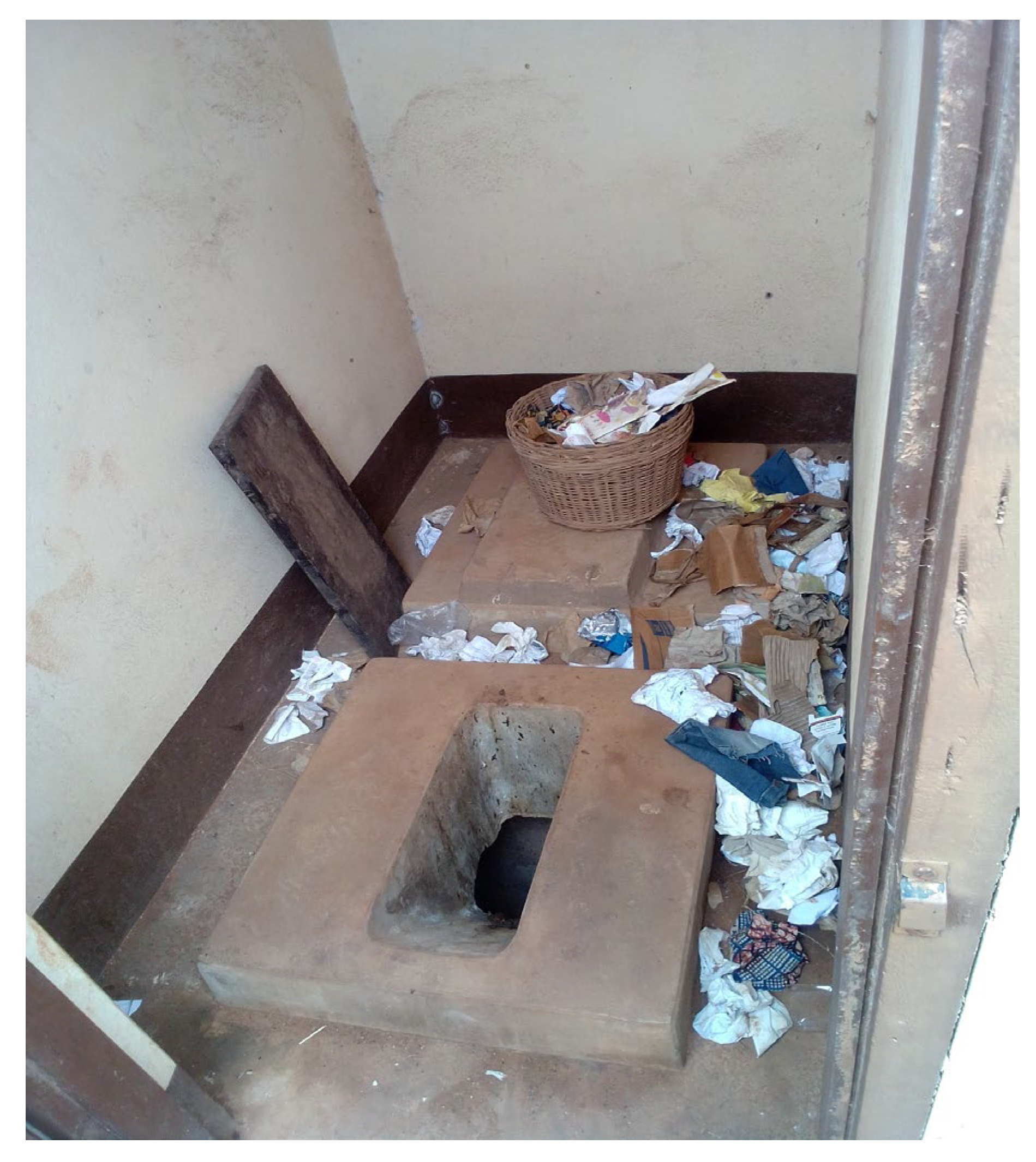
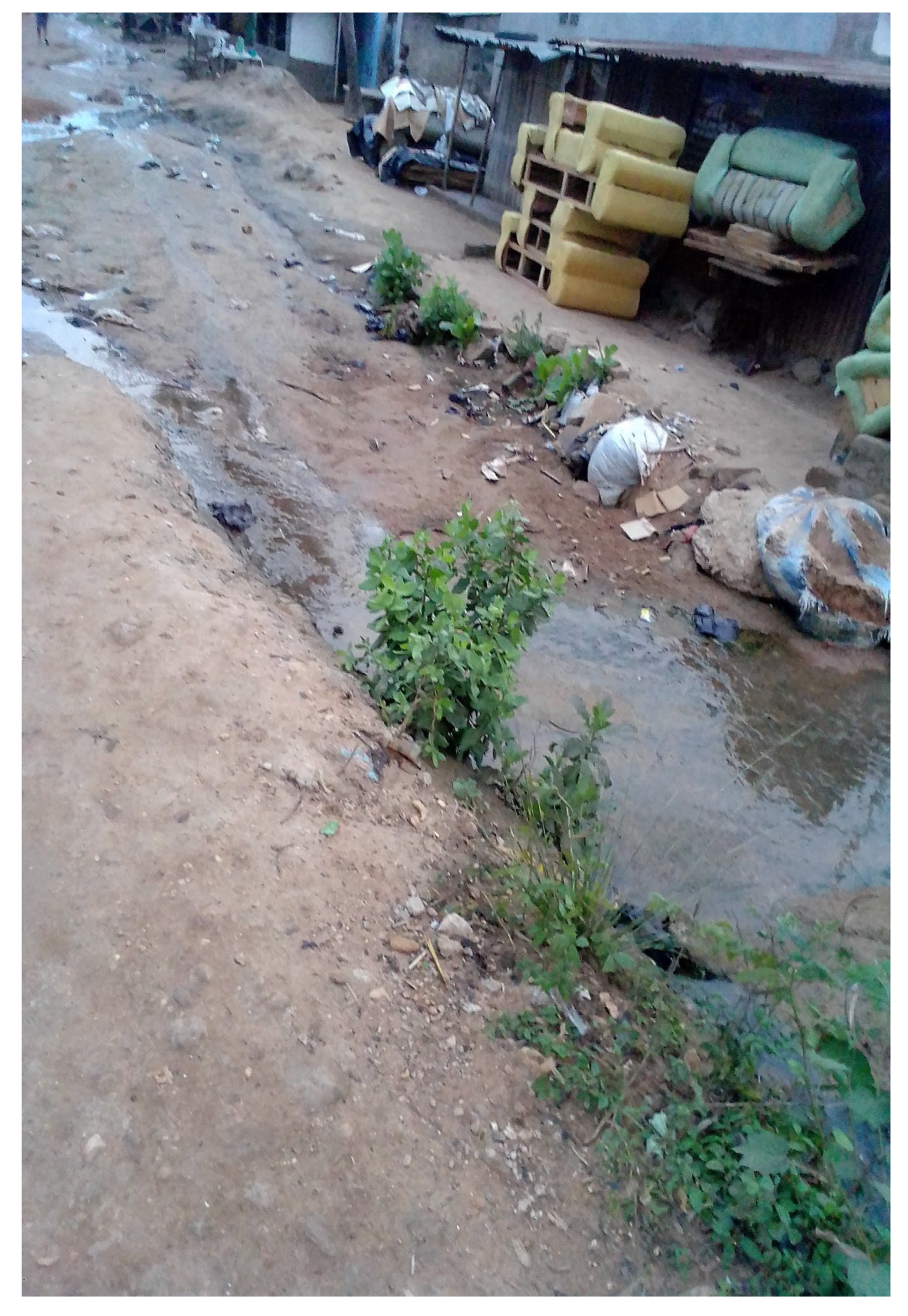
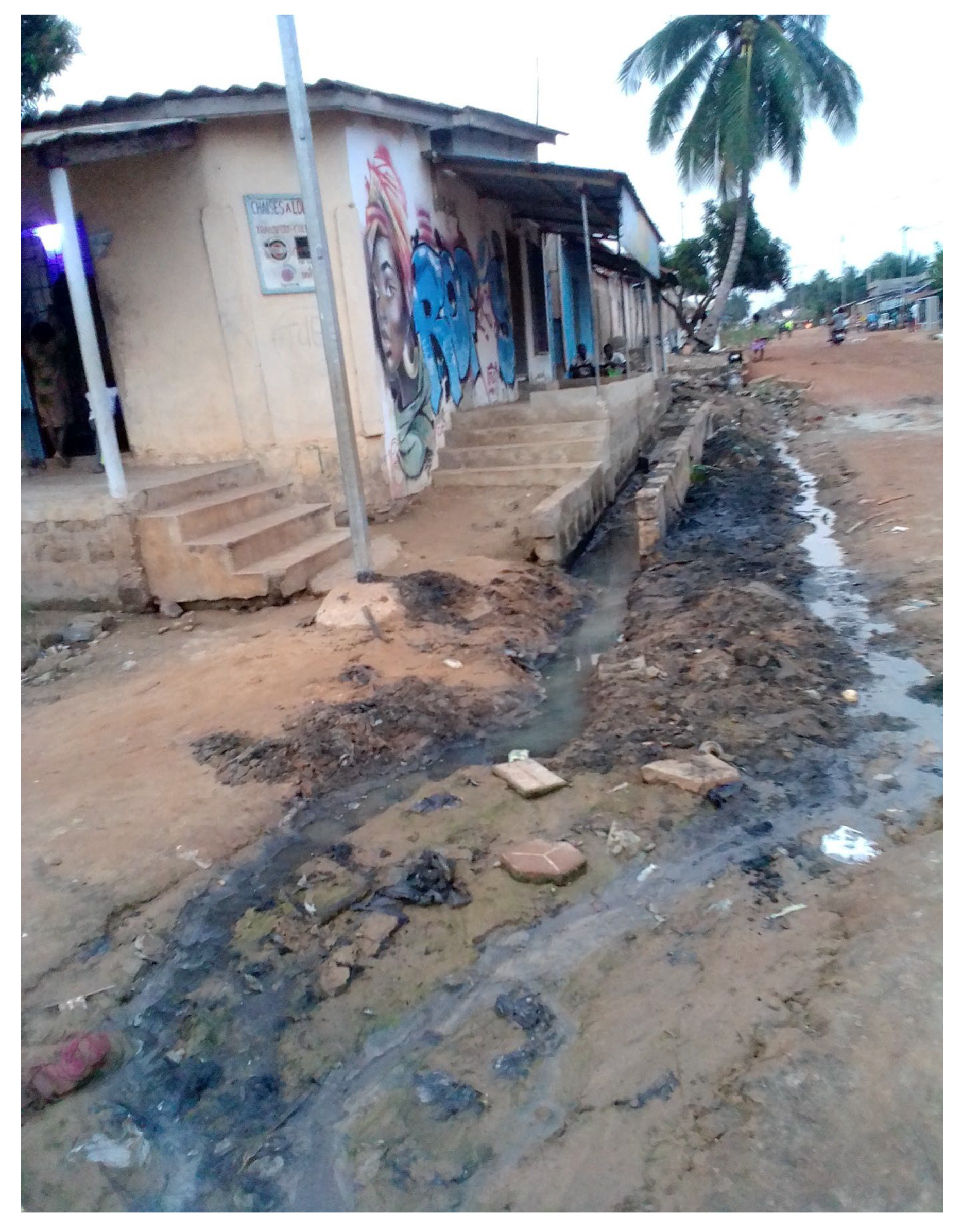
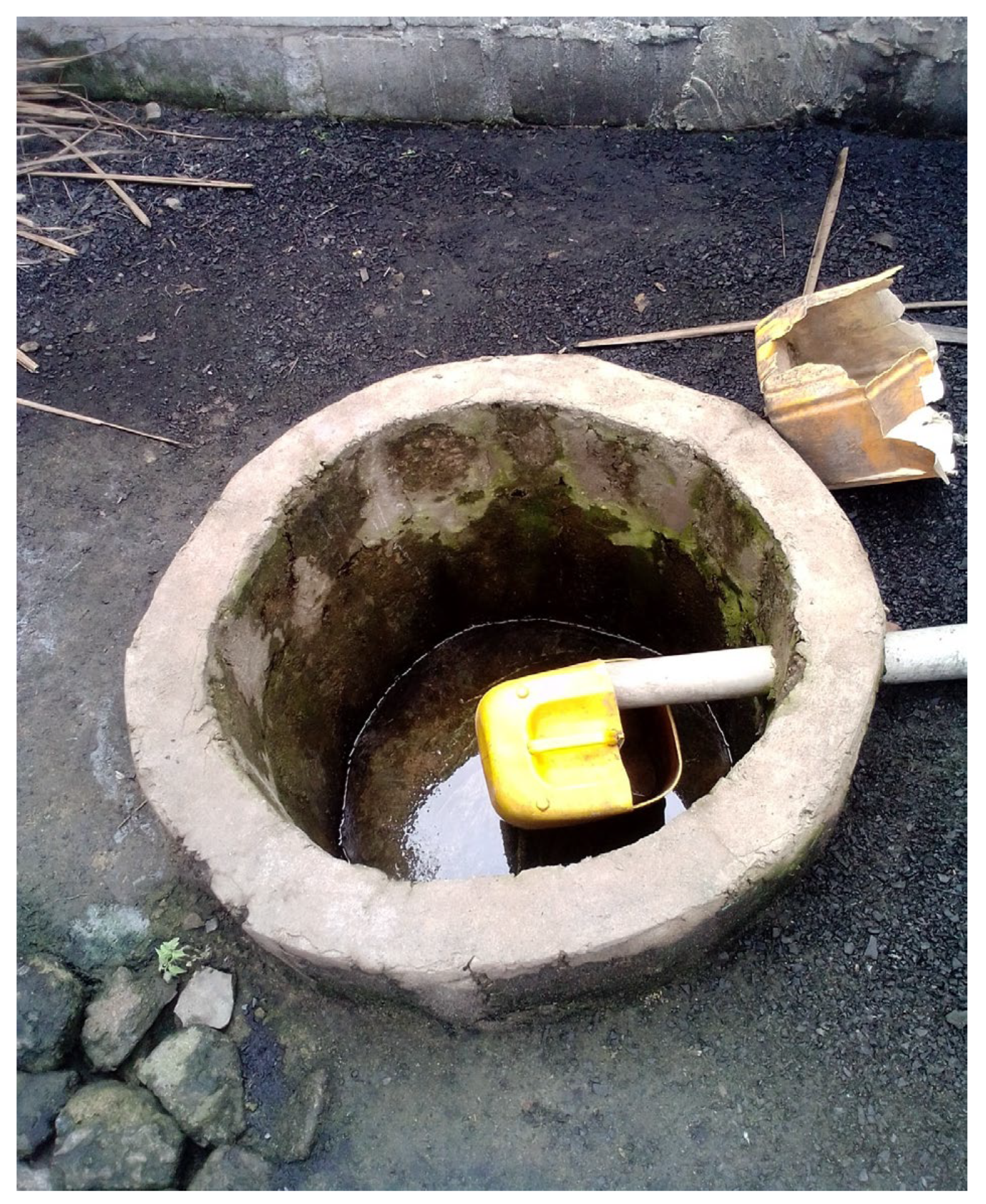
3.4. Knowledge of Wastewater Management
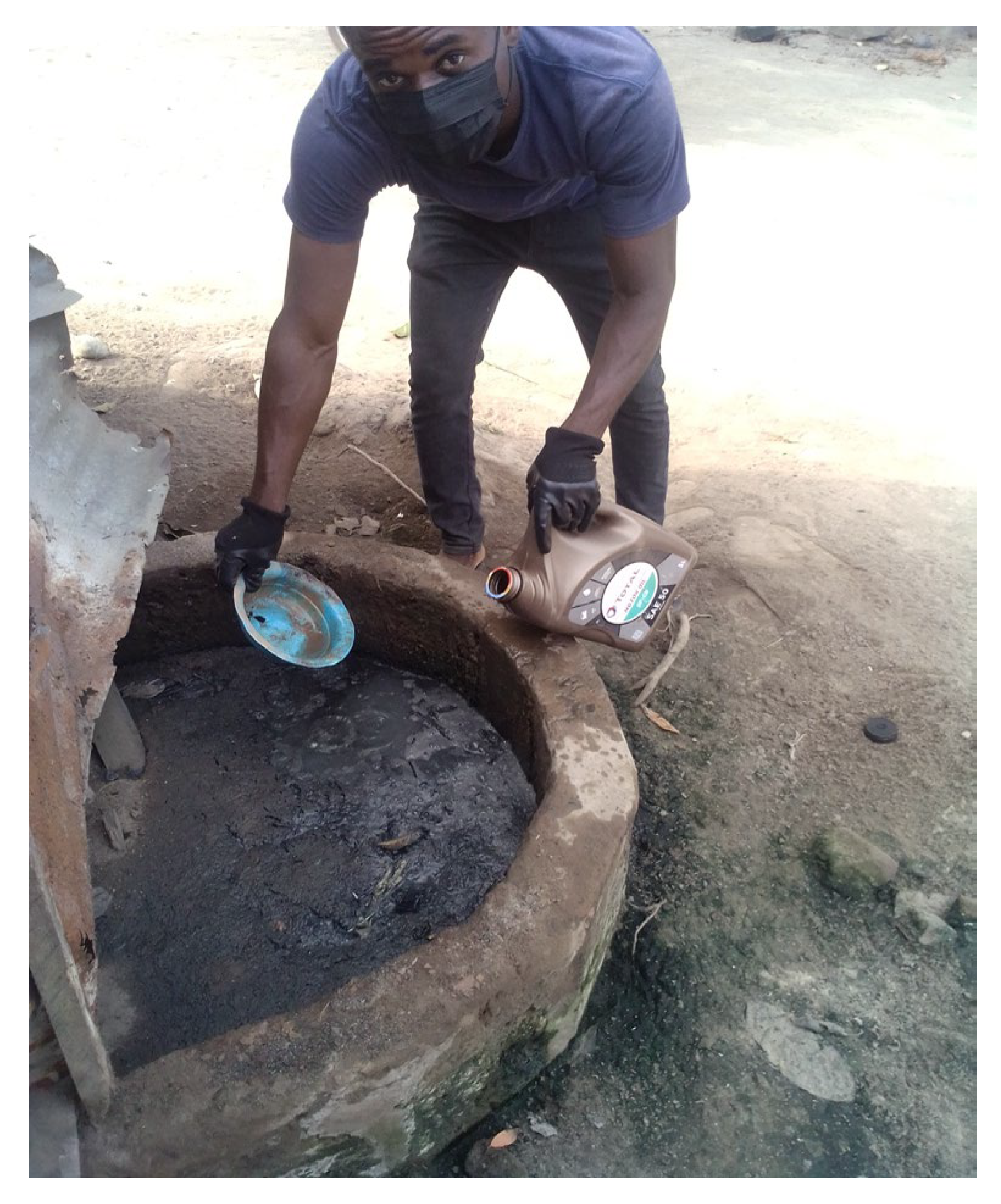
3.4.1. Raising Awareness of Sanitation Issues in the Hygiene Department
3.4.2. Interview with the Head of the Basic Hygiene and Sanitation Department
3.4.3. Interview with the Head of the Town Hall’s Technical Division
3.4.4. Interview with the Head of the Village Development Committee
3.4.5. Interview with the Town Hall Councilor
3.4.6. Observation Grid for the General Environment of the Village
4. Discussion
5. Conclusions
Author Contributions
Funding
Institutional Review Board Statement
Informed Consent Statement
Data Availability Statement
Acknowledgments
Conflicts of Interest
References
- Attar, M. Les Enjeux de La Gestion Des Déchets Ménagers et Assimilés En France En 2008; Direction des Journaux Officiels: Paris, France, 2008. [Google Scholar]
- Koné-Bodou Possilétya, J.; Kouamé, V.K.; Fé Doukouré, C.; Yapi, D.A.C.; Kouadio, A.S.; Ballo, Z.; Sanogo, T.A. Risques sanitaires liés aux déchets ménagers sur la population d’Anyama (Abidjan-Côte d’Ivoire). VertigO Rev. Électronique Sci. L’environ. 2019, 19. [Google Scholar] [CrossRef]
- Diabagate, S.; Konan, K.P. Gestion Des Ordures Ménagères Dans La Ville de Bouaké, Sources d’inégalités Socio-Spatiales et Environnementales. Rev. Espace Territ. Sociétés Santé 2018, 1, 126–142. [Google Scholar]
- Habbari, K.; Najih, A.; Amir, S.; Agbalou, A. Gestion des dechets menagers dans la ville de khouribga (maroc): Etude du comportement du citoyen. ScienceLib Ed. Mersenne 2014, 6, 140607. [Google Scholar]
- Gbekley, E.H.; Kouawo, A.C.A.; Awokou, K. L’éducation Relative à l’environnement (ERE) Au Togo: Evaluation Du Paradigme de Formation 2021. Available online: www.uac.bj (accessed on 16 August 2021).
- Kondoh, E.; Bodjona, M.B.; Aziable, E.; Tchegueni, S.; Kili, K.A.; Tchangbedji, G. Etat Des Lieux de La Gestion Des Déchets Dans Le Grand Lomé. Int. J. Biol. Chem. Sci. 2019, 13, 2200–2209. [Google Scholar] [CrossRef]
- JICA Projet d’Assainissement Des Eaux Usées, Des Eaux Pluviales et Des Déchets Solides de La Ville de Kaolack En République Du Sénégal. CTI Engineering International—Recherche Google. Available online: https://www.google.com/search?hl=fr&q=Projet+d%27Assainissement+des+Eaux+Us%C3%A9es,+des+Eaux+Pluviales+et+des+D%C3%A9chets+Solides+de+la+ville+de+Kaolack+en+R%C3%A9publique+du+S%C3%A9n%C3%A9gal.+CTI+Engineering+International (accessed on 11 July 2023).
- Silva, J.A. Wastewater Treatment and Reuse for Sustainable Water Resources Management: A Systematic Literature Review. Sustainability 2023, 15, 10940. [Google Scholar] [CrossRef]
- DGSNC Ministère Auprès Du Président de La République, Chargé de La Planification, Du Développement et de L’aménagement Du Territoire. Available online: https://planification.gouv.tg/ (accessed on 11 July 2023).
- QUIBB. Rapport Enquête QUIBB; MPDAT-DGSCN République Togolaise: Lomé, Togo, 2015. [Google Scholar]
- Ministère de l’Environnement et des Ressources Forestières du Togo. Loi No 2008-005 Du 30 Mai 2008 Portant Loi-Cadre Sur l’environnement. 2008, p. 37. Available online: https://www.informea.org/fr/legislation/loi-n%C2%BA-2008-005-portant-loi-cadre-sur-lenvironnement (accessed on 22 February 2022).
- MSHPAUS Politique Nationale de Santé, Togo. Available online: https://www.afro.who.int/fr/publications/politique-nationale-de-sante-togo (accessed on 9 October 2022).
- DGSCN; PNUD; UNICEF RGPH. Résultats Définitifs Du Recensement Général de La Population Du 06 Au 21 Novembre 2010; Présidence de la République Togolaise, Ed.; Présidence de la République Togolai: Lomé, Togo, 2010; Available online: https://microdata.worldbank.org/index.php/catalog/2002 (accessed on 26 February 2022).
- ATOP-Togo Plateforme Industrielle d’Adétikopé: Le Rapport de l’étude d’impact Environnemental et Social Présenté aux Populations de Akplomé et Dzové 2020. Available online: https://atoptg.com/plateforme-industrielle-dadetikope-le-rapport-de-letude-dimpact-environnemental-et-social-presente-aux-populations-de-akplome-et-dzove/ (accessed on 22 February 2022).
- Takili, M.; Danvide, T.B.; Banon, F. Adétikopé, un Pôle Urbain Émergent à Lomé: Entre Dynamisme de la Migration Résidentielle et de la Masse Urbaine. Regard Sud 2022. Available online: https://regardsuds.org/adetikope-un-pole-urbain-emergent-a-lome-entre-dynamisme-de-la-migration-residentielle-et-de-la-masse-urbaine/ (accessed on 8 October 2022).
- Gbekley, H.H.; Komi, K.; Houedakor, K.Z.; Poli, S.; Kpoezoum, K.; Adjalo, D.K.; Zinsou-Klassou, K.; Tchacondo, T.; Ameyapoh, Y.; Adjoussi, P. Physico-Chemical and Bacteriological Characterisation of Domestic Wastewater from Adétikopé in Togo 2023. Available online: https://www.preprints.org/manuscript/202307.2099/v1 (accessed on 31 July 2023).
- Ministère de l’Urbanisme, de l’Habitat et du Cadre de Vie de la République Togolaise. Elaboration Du Schéma Directeur d’Aménagement et d’Urbanisme (SDAU) Du Grand Lomé. 2018. 15p. Available online: https://urbanisme.gouv.tg/le-ministere-de-lurbanisme-de-lhabitat-et-de-la-reforme-fonciere-a-dote-quarante-huit-48-communes-et-le-treize-13-du-grand-lome-de-schemas-directeurs-damenagement/ (accessed on 11 July 2023).
- Robert Magnani et Echantillonage Guide d’Echantillonnage. Available online: https://www.bing.com:9943/search?q=Robert+Magnani+et+echantillonage&form=ANNTH1&refig=3da28ced7efe4ade9bda7c66ea89acac (accessed on 24 February 2023).
- Guidi, A. Disponibilité de L’eau Potable et Santé Des Populations de La Localité d’Adétikopé. Master’s Thesis, Université de Lomé, Ecole des Assistants Médicaux, Lomé, Togo, 2020. [Google Scholar]
- Titone, B. Etat Des Lieux de La Gestion Des Déchets Ménagers Solides et Liquides Dans La Commune Agou1 de La Préfecture d’Agou: Cas de La Ville de Gadzépé. Master’s Thesis, Université de Lomé, Ecole des Assistants Médicaux, Lomé, Togo, 2020. [Google Scholar]
- Tchakou, T. Etat Des Lieux de l’assainissement Dans La Commune Vo3. Master’s Thesis, Université de Lomé, Ecole des Assistants Médicaux, Lomé, Togo, 2022. [Google Scholar]
- Dinégré, M. Etat Des Lieux de L’assainissement de L’hygiène et de L’approvisionnement En Eau Potable de La Commune de Notsè. Master’s Thesis, Université de Lomé, Ecole des Assistants Médicaux, Lomé, Togo, 2016. [Google Scholar]
- Nyakpo, A. Etat Des Lieux de La Gestion Des Déchets Ménagers Solides et Liquides Dans La Commune Vo1 de La Préfecture de Vo: Cas de La Ville de Vogan. Master’s Thesis, Université de Lomé, Ecole des Assistants Médicaux, Lomé, Togo, 2022. [Google Scholar]
- Awou, K. Contribution à L’amélioration de La Gestion Des Excréta et Eaux Usées Dans La Ville de Kpalimé. Mémoire de licence de Technicien Supérieur en Génie Sanitaire, Université de Lomé, Ecole des Assistants Médicaux, Lomé, Togo, 2011. [Google Scholar]
- 25. Kpizou Etat Des Lieux de La Gestion Des Déchets Ménagers Dans La Commune d’Agoé Nyivé 6: Cas de La Localité d’Adétikopé Centre. Master’s Thesis, Université de Lomé, Ecole des Assistants Médicaux, Lomé, Togo, 2022.
- Tchindou, P. Etude Diagnostique de La Gestion Des Boues de Vidange Dans La Ville de Tsévié Au Togo. Master’s Thesis, Université de Lomé, Ecole des Assistants Médicaux, Lomé, Togo, 2019. [Google Scholar]
- Ali, A. Problématique de l’assainissement Au Togo: Cas Du Quartier Haoussa-Zongo/Togblékopé Dans La Préfecture Du Golfe. Master’s Thesis, Université de Lomé, Ecole des Assistants Médicaux, Lomé, Togo, 2014. [Google Scholar]
- Mukuku, O.; Musung, J.; Samba, C.; Tshibanda, K.; Zalula, C.; Bamba, M.; Luboya, N. Évaluation de La Gestion Des Déchets Ménagers Dans La Commune de Katuba à Lubumbashi (République Démocratique Du Congo). Rev. Infirm. Congo. 2018, 2, 50–56. [Google Scholar]
- Ahatefou, E.L.; Koriko, M.; Koledzi, K.E.; Tchegueni, S.; Tchangbédji, G.; Hafidi, M. Diagnostic Du Système de Collecte Des Excréta et Eaux Usées Domestiques Dans Les Milieux Inondables de La Ville de Lomé: Cas Du Quartier Zogbedji. Déchets Sci. Tech. 2013, 65, 12–19. [Google Scholar] [CrossRef]
- Gabert, J. Mémento de l’Assainissement; Éditions Quae. 2018. Available online: https://library.oapen.org/handle/20.500.12657/23962 (accessed on 11 March 2023).
- PEA-OMD Guide Opérationnel de l’Assainissement Autonome Des Excréta et Eaux Usées Au Togo. Available online: https://www.bing.com/search?q=PEA-OMD.+%282016%29.+Guide+Op%C3%A9rationnel+de+l%E2%80%99Assainissement+Autonome+des+Excr%C3%A9ta+et+Eaux+Us%C3%A9es+au+Togo.+161p&qs=n&form=QBRE&sp=-1&pq=porno&sc=1-5&sk=&cvid=86806E52E1754318A0A49456CBFFBC9B&ghsh=0&ghacc=0&ghpl= (accessed on 9 October 2022).
- Attisso, A. Etude Diagnostique de La Gestion Des Déchets Solides et Liquides Dans La Commune de Bassar. Région de La Kara. Master’s Thesis, Université de Lomé, Ecole des Assistants Médicaux, Lomé, Togo, 2015. [Google Scholar]
- Gui, Z.; Wen, J.; Fu, L.; Wang, S.; Zheng, B. Analysis on Mode and Benefit of Resource Utilization of Rural Sewage in a Typical Chinese City. Water 2023, 15, 2062. [Google Scholar] [CrossRef]
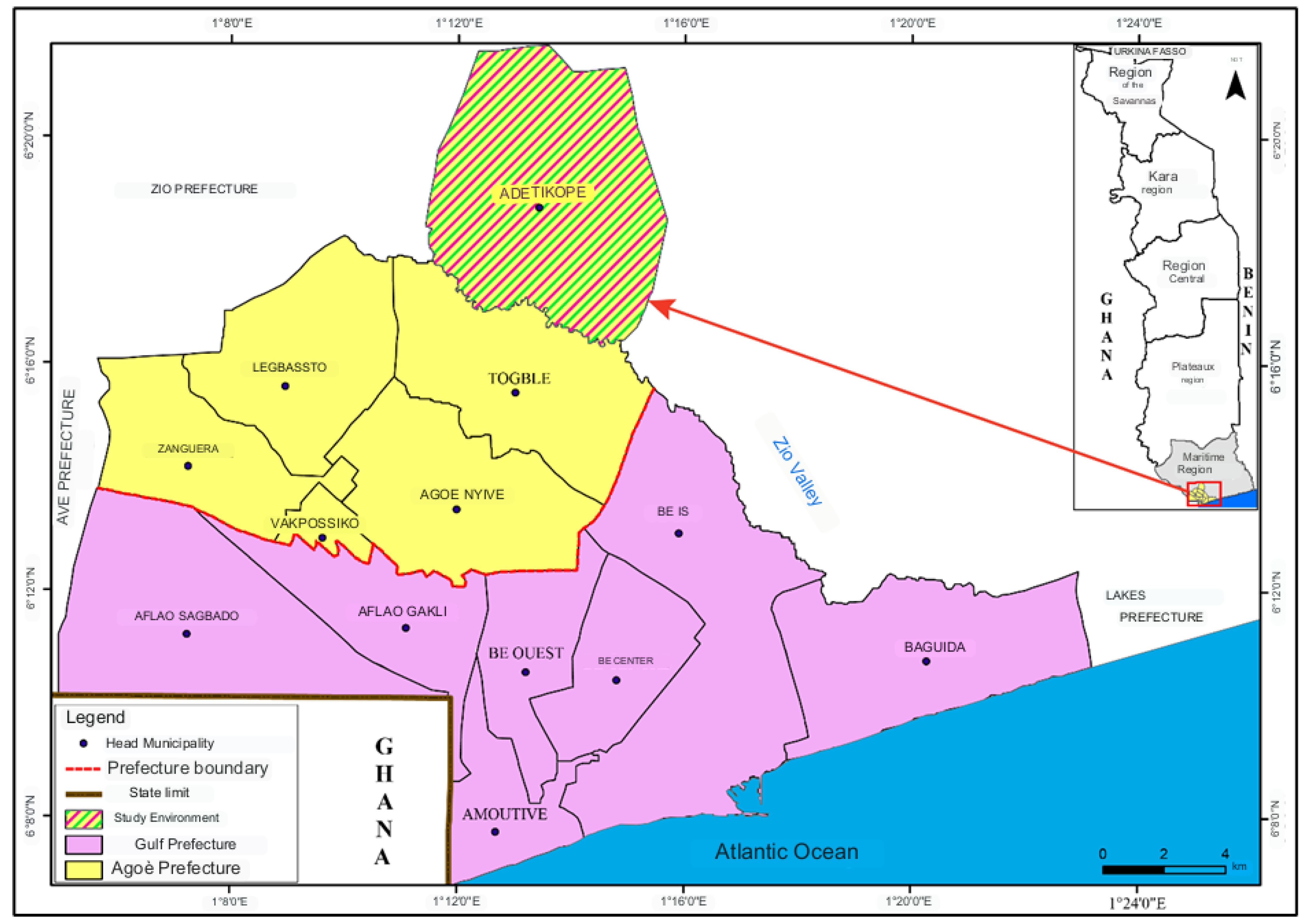
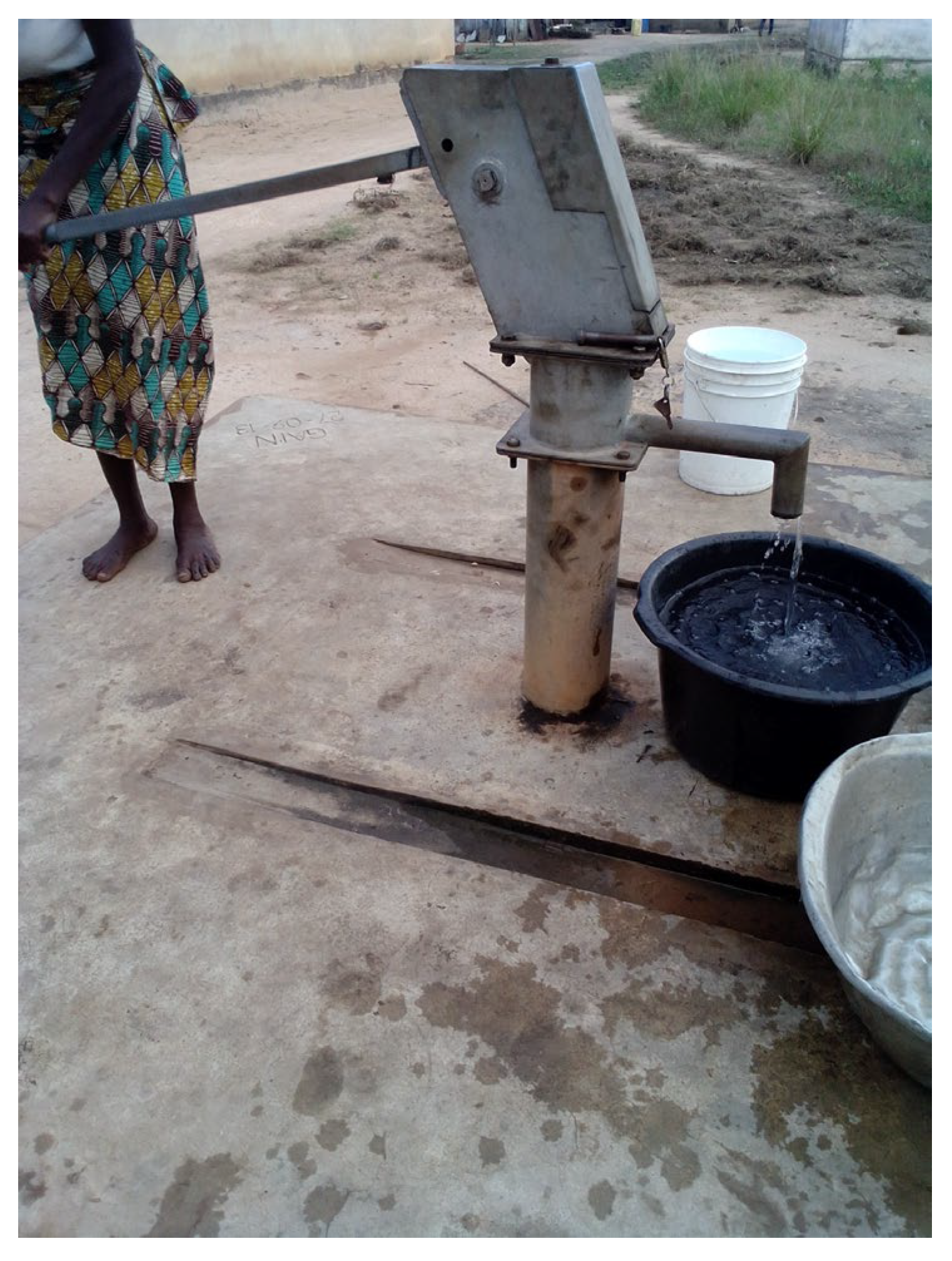
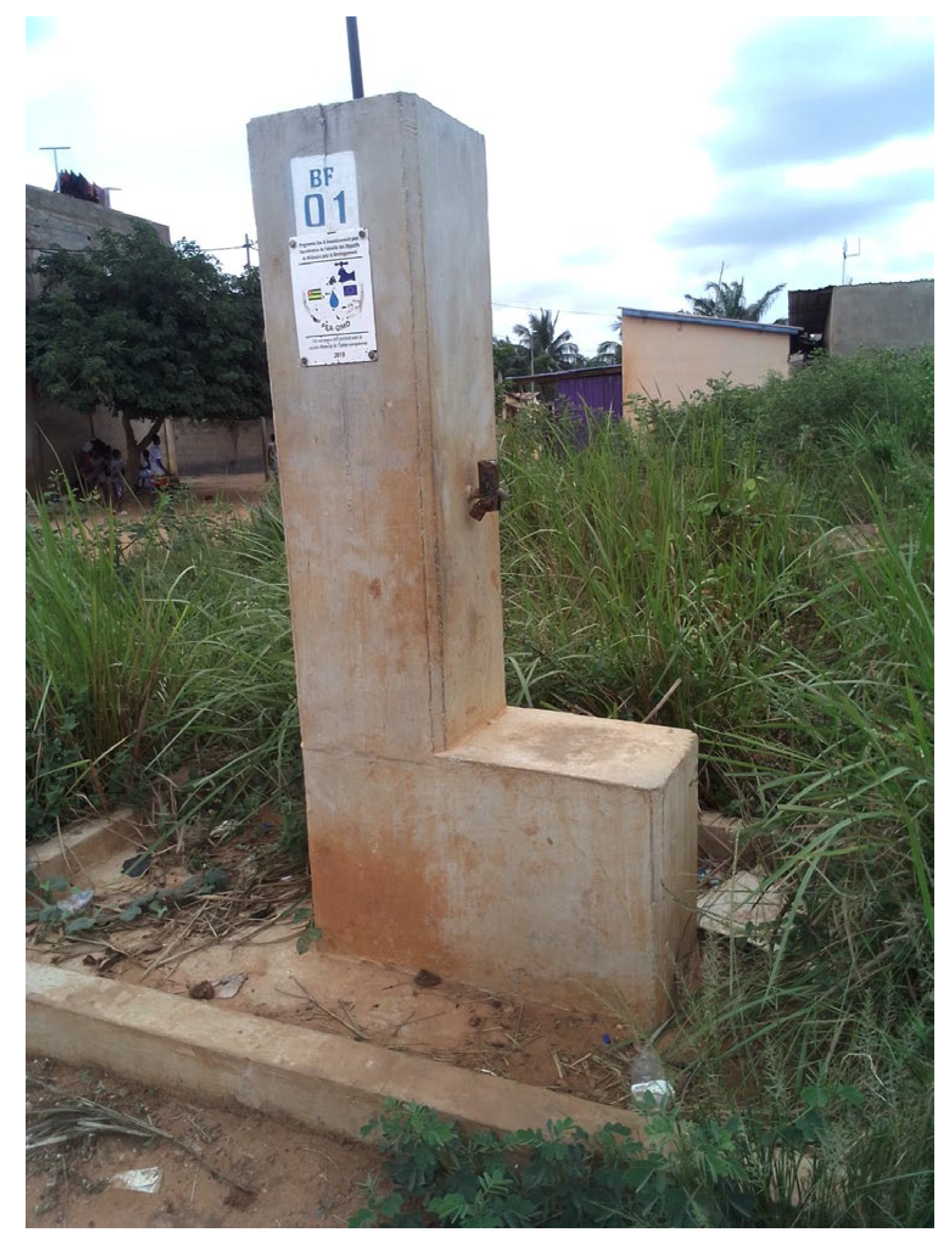
| 12 Villages of Adétikopé | Number of Men | Number of Women | Total | Total Households Surveyed |
|---|---|---|---|---|
| Adetikope-Centre | 8708 | 9325 | 18,033 | 1128 |
| Agnave | 3625 | 3687 | 7312 | 458 |
| Devime | 5098 | 5447 | 10,545 | 660 |
| Dzove | 3104 | 3098 | 6202 | 388 |
| Adoglove | 2134 | 2169 | 4303 | 269 |
| Lomenyo KOPE | 2075 | 2120 | 4195 | 263 |
| Kpokpome-Agute | 13,608 | 14,385 | 27,993 | 1752 |
| Agotime | 1923 | 1901 | 3824 | 239 |
| Kladjeme | 4253 | 4371 | 8624 | 540 |
| Kpotave | 5432 | 5632 | 11,064 | 693 |
| Tonoukouti | 2396 | 2466 | 4862 | 304 |
| Tsikplonou-Kondji | 1554 | 1,683 | 3237 | 203 |
| Total Commune Agoe-Nyive 6 | 53,910 | 56,284 | 110,194 | 6898 |
| Technical | Tools | Target |
|---|---|---|
| Observation | Observation grid | General neighborhood environment Household environment |
| Maintenance | Interview guide | Head of the town hall’s technical division Head of the CMS hygiene and sanitation department Head of CDV Town councilor and secretary |
| Questionnaire survey | Questionnaire | Head of household/representative |
| Literature review | Tabulation sheet | Consultation register, scientific websites |
| Indicators | Terms | % | p. Values |
|---|---|---|---|
| Neighborhoods | Adétikopé Adoglové | 15.07% | <0.05 |
| Adétikopé Agnavé | 21.92% | - | |
| Adétikopé Agotimé | 6.16% | <0.001 | |
| Adétikopé Centre | 12.33% | <0.001 | |
| Adétikopé Dévimé | 4.11% | <0.001 | |
| Adétikopé Djové | 2.05% | <0.001 | |
| Adétikopé Kladjémé | 6.85% | <0.001 | |
| Adétikopé Agouté | 10.96% | <0.001 | |
| Adétikopé Kpotavé | 5.48% | <0.001 | |
| Adétikopé Lomenyo Kopé | 4.11% | <0.001 | |
| Adétikopé Tonoukouti | 3.42% | <0.001 | |
| Adétikopé Tsikponou Kondji | 7.53% | <0.001 | |
| Total | 100.00% | ||
| Gender | Female | 72.60% | - |
| Male | 27.40% | <0.001 | |
| Total | 100.00% | ||
| Age | [0–20] | 0.68% | <0.001 |
| [20–30] | 19.98% | <0.001 | |
| [30–40] | 39.61% | - | |
| [40–50] | 20.55% | <0.001 | |
| [50–60] | 15.75% | <0.001 | |
| [60–70] | 3.42% | <0.001 | |
| Total | 100.00% | ||
| Occupancy status | Rental | 30.14% | <0.001 |
| Family properties | 16.44% | <0.001 | |
| Personal properties | 53.42% | - | |
| Total | 100.00% | ||
| Religions | Animist | 8.90% | <0.001 |
| Christian | 70.55% | - | |
| Muslim | 20.55% | <0.001 | |
| Total | 100.00% | ||
| Level of education | Out of school | 9.59% | <0.001 |
| Primary | 22.60% | <0.001 | |
| Secondary | 64.38% | - | |
| University | 3.42% | <0.001 | |
| Total | 100.00% |
| Indicators | Terms | % | p. Values |
|---|---|---|---|
| Main occupation of head of household | Farmer | 8.90% | <0.05 |
| Artisan | 17.12% | <0.05 | |
| Car/Motorcycle Taxi Driver | 0.68% | <0.001 | |
| Shopkeeper | 29.45% | - | |
| Housekeeper | 24.66% | <0.05 | |
| Retailer | 8.90% | <0.001 | |
| Employee | 8.90% | <0.001 | |
| Other | 1.37% | <0.001 | |
| Total | 100.00% | ||
| Average household sizeMode | M-1 | 2.05% | <0.001 |
| M-2 | 4.79% | <0.001 | |
| M-3 | 13.01% | <0.06 | |
| M-4 | 19.86% | <0.09 | |
| M-5 | 10.27% | <0.001 | |
| M-6 | 20.66% | - | |
| M-7 | 10.33% | <0.05 | |
| M-8 | 9.65% | <0.05 | |
| M-9 | 5.54% | <0.05 | |
| M-10 | 2.11% | <0.001 | |
| M-11 | 0.06% | <0.001 | |
| M-12 | 0.06% | <0.001 | |
| M-13 | 0.06% | <0.001 | |
| M-14 | 0.06% | <0.001 | |
| M-15 | 0.06% | <0.001 | |
| M-16 | 0.34% | <0.001 | |
| M-20 | 0.29% | <0.001 | |
| M-24 | 0.40% | <0.001 | |
| M-32 | 0.40% | <0.001 | |
| Total | 100.00% |
| Indicators | Terms | % | p. Values |
|---|---|---|---|
| Main source of drinking water | TDE * (Togolese of the waters) only | 6.16% | <0.001 |
| TDE and drilling | 1.37% | <0.001 | |
| Drilling only | 74.66% | - | |
| Drilling and wells | 9.59% | <0.001 | |
| Well only | 6.85% | <0.001 | |
| Wells and TDE | 1.37% | <0.001 | |
| Total | 100.00% | ||
| Use made of water TDE | Drinks and cooking | 2.05% | <0.001 |
| Shower and laundry | 1.37% | <0.001 | |
| All | 5.48% | <0.001 | |
| Do not use | 91.10% | - | |
| Total | 100.00% | ||
| Water used for drinking | Conditioned water | 8.90% | <0.001 |
| Borehole water | 80.14% | - | |
| Well water | 4.11% | <0.001 | |
| TDE water | 6.85% | <0.001 | |
| Total | 100.00% | ||
| Water used for cooking | Drilling | 72.60% | - |
| Drilling and wells | 3.42% | <0.001 | |
| Well | 15.07% | <0.001 | |
| TDE water | 8.90% | <0.001 | |
| Total | 100.00% | ||
| Water used for showering | Drilling | 70.55% | - |
| Well | 21.92% | <0.001 | |
| TDE | 7.53% | <0.001 | |
| Total | 100.00% | ||
| TDE water source | TDE subscriber | 93.38% | - |
| Fountain bollard | 6.62% | <0.001 | |
| Total | 100.00% | ||
| Satisfaction with TDE services | Satisfied | 23.08% | <0.05 |
| Not very satisfied | 30.77% | <0.05 | |
| Not satisfied | 38.46% | - | |
| Does not wish to express | 7.69% | <0.001 | |
| Total | 100.00% |
| Indicators | Terms and Conditions | % | Capital Gains |
|---|---|---|---|
| Knowledge of wastewater management | Yes | 58.22% | <0.001 |
| No | 41.78% | <0.001 | |
| Total | 100.00% | <0.001 | |
| Information channel on wastewater management knowledge | Media | 56.22% | <0.001 |
| Rue | 2.00% | <0.001 | |
| NA | 43.15% | <0.001 | |
| Total | 101.37% | <0.001 | |
| Knowledge of wastewater reclamation | Yes | 62.33% | <0.001 |
| No | 36.30% | <0.001 | |
| No answer | 1.37% | <0.001 | |
| 100.00% | <0.001 | ||
| Knowledge of the health hazards of wastewater | Yes | 96.58% | <0.001 |
| No | 2.74% | <0.001 | |
| No answer | 0.68% | <0.001 | |
| 100.00% | <0.001 |
Disclaimer/Publisher’s Note: The statements, opinions and data contained in all publications are solely those of the individual author(s) and contributor(s) and not of MDPI and/or the editor(s). MDPI and/or the editor(s) disclaim responsibility for any injury to people or property resulting from any ideas, methods, instructions or products referred to in the content. |
© 2023 by the authors. Licensee MDPI, Basel, Switzerland. This article is an open access article distributed under the terms and conditions of the Creative Commons Attribution (CC BY) license (https://creativecommons.org/licenses/by/4.0/).
Share and Cite
Gbekley, E.H.; Houedakor, K.Z.; Komi, K.; Poli, S.; Adjalo, D.K.; Nyakpo, A.; Ayivigan, A.M.; Ali, A.A.G.V.; Zinsou-Klassou, K.; Adjoussi, P. Urban Governance and Sanitation in the Peri-Urban Commune of Agoè-Nyvé 6 in Togo: Diagnosis of the Sanitation System in Adétikopé. Water 2023, 15, 3306. https://doi.org/10.3390/w15183306
Gbekley EH, Houedakor KZ, Komi K, Poli S, Adjalo DK, Nyakpo A, Ayivigan AM, Ali AAGV, Zinsou-Klassou K, Adjoussi P. Urban Governance and Sanitation in the Peri-Urban Commune of Agoè-Nyvé 6 in Togo: Diagnosis of the Sanitation System in Adétikopé. Water. 2023; 15(18):3306. https://doi.org/10.3390/w15183306
Chicago/Turabian StyleGbekley, Efui Holaly, Koko Zébéto Houedakor, Kossi Komi, Sossawè Poli, Djiwonou Koffi Adjalo, Ablam Nyakpo, Ayayivi Mensah Ayivigan, Abdourahamane Aissa Ghanny Vanessa Ali, Kossiwa Zinsou-Klassou, and Pèssiezoum Adjoussi. 2023. "Urban Governance and Sanitation in the Peri-Urban Commune of Agoè-Nyvé 6 in Togo: Diagnosis of the Sanitation System in Adétikopé" Water 15, no. 18: 3306. https://doi.org/10.3390/w15183306
APA StyleGbekley, E. H., Houedakor, K. Z., Komi, K., Poli, S., Adjalo, D. K., Nyakpo, A., Ayivigan, A. M., Ali, A. A. G. V., Zinsou-Klassou, K., & Adjoussi, P. (2023). Urban Governance and Sanitation in the Peri-Urban Commune of Agoè-Nyvé 6 in Togo: Diagnosis of the Sanitation System in Adétikopé. Water, 15(18), 3306. https://doi.org/10.3390/w15183306







